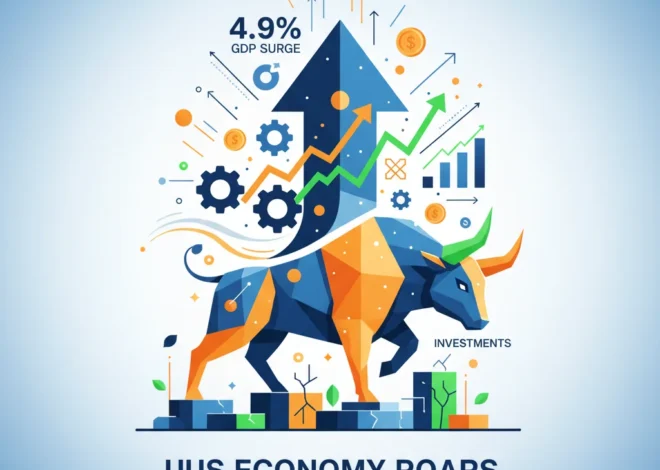
Solving the Financial Puzzle: A Strategic Guide to Today’s Complex Economy
Every morning, enthusiasts around the world open the Financial Times, not just for market-moving headlines, but for a different kind of challenge: the daily crossword. It begins as a blank grid, a matrix of empty squares filled with cryptic clues. Solving it requires more than just a strong vocabulary; it demands pattern recognition, lateral thinking, and the ability to connect seemingly disparate pieces of information into a coherent whole. This daily ritual serves as a powerful metaphor for the challenge facing today’s investors, business leaders, and finance professionals.
The global economy is our crossword grid. The clues are a complex mix of macroeconomic data, shifting geopolitical landscapes, disruptive technologies, and evolving consumer behaviors. To succeed, we must learn to decipher these clues, understand how they intersect, and gradually fill in the blanks to reveal the bigger picture. This isn’t just an intellectual exercise; it’s essential for navigating the intricate worlds of investing, banking, and corporate strategy. In this guide, we’ll break down the key sections of this financial puzzle, from the foundational “across” clues of the macro-economy to the cryptic “down” clues of emerging technologies like blockchain.
The Macro Clues: Understanding the Economic Framework
Before you can solve any single word in a puzzle, you must understand the rules of the game. In finance, the overarching rules are set by the field of economics. Macroeconomic indicators are the “1 Across” and “1 Down” clues that define the entire grid’s structure. These are the broad-stroke trends that influence every other decision.
Consider key indicators like:
- Gross Domestic Product (GDP): Is the economy expanding or contracting? A growing GDP often signals a healthy environment for corporate earnings and, by extension, the stock market.
- Inflation Rates: How quickly are prices rising? Central banks combat high inflation by raising interest rates, which can cool down the economy and make borrowing more expensive for both companies and consumers.
- Employment Data: A strong labor market suggests consumer confidence and spending power, but it can also fuel inflationary pressures.
Interpreting these clues is a delicate art. For instance, a blockbuster jobs report might seem like unequivocally good news. However, a market-savvy analyst, much like a seasoned crossword solver, might see a hidden meaning. Strong employment could lead the central bank to maintain high interest rates, potentially putting downward pressure on stock valuations. This interplay between data points is crucial. According to the kind of in-depth analysis often found in leading financial publications, these indicators rarely move in isolation (source). Understanding their interconnectedness is the first step toward building a sound investment thesis.
From Belfast to Wall Street: Why Confronting the Past is the Future of Finance
The Foundational Grid: Traditional Finance and Banking
If macroeconomics sets the rules, the traditional banking and finance sectors form the grid itself. These are the established institutions, regulations, and systems through which capital flows. For centuries, this framework has been relatively stable, governed by central banks, regulated commercial banks, and established stock exchanges. This system provides the essential infrastructure for everything from personal savings accounts to multi-billion dollar corporate mergers.
However, to assume this grid is static is a critical mistake. The rise of financial technology is challenging the status quo, forcing legacy institutions to adapt or risk becoming obsolete. While traditional banks offer stability and trust built over decades, fintech startups promise efficiency, lower costs, and a superior user experience. This dynamic creates both tension and opportunity within the financial sector.
Here is a comparison of how traditional banking and emerging fintech models approach common financial services:
| Financial Service | Traditional Banking Approach | Fintech Approach |
|---|---|---|
| Personal Loans | In-person or lengthy online application, based on traditional credit scores. Slower approval times. | Digital-first application, using alternative data for credit assessment. Faster, often automated, approval. |
| Investing & Trading | Often requires a human broker or wealth manager, higher fees, and larger minimum investments. | App-based platforms, commission-free trading, fractional shares, and robo-advisors. |
| International Payments | Wire transfers via SWIFT network, typically slow (2-5 business days) and expensive with opaque fees. | Peer-to-peer networks, transparent fee structures, and near-instantaneous transfers. |
| Business Banking | Focus on established businesses, extensive paperwork, and physical branch networks. | Digital-native accounts, integrated invoicing and payroll software, and streamlined onboarding for startups. |
The Disruptive Clues: The Rise of Fintech
Fintech, a portmanteau of “financial technology,” represents some of the most exciting and challenging clues in our modern economic puzzle. These are the companies rewriting the rules of investing, payments, and lending. They leverage software, data analytics, and mobile technology to offer services that are faster, cheaper, and more accessible than traditional alternatives.
The impact of fintech is multifaceted. It has democratized access to financial markets through commission-free trading apps, allowing retail investors to participate in a way that was previously unimaginable. It has streamlined global commerce with efficient payment gateways and transformed consumer lending with data-driven approval processes. This technological wave is not a passing trend; it is a fundamental restructuring of the financial services industry, a fact highlighted by the continuous flow of venture capital into the sector (source). For business leaders, ignoring the fintech revolution is like trying to solve a modern crossword with a 19th-century dictionary—you’ll be missing all the new words.
The Cryptic Corner: Demystifying Blockchain
Every complex crossword has a “cryptic corner”—a set of clues that are intentionally obscure and require a different way of thinking. In the financial world, this corner is occupied by blockchain and its associated technologies.
At its core, a blockchain is a distributed, immutable digital ledger. Let’s break that down:
- Distributed: Instead of being stored in one central place (like a bank’s server), the ledger is copied and spread across a network of computers. This decentralization makes it highly resistant to single points of failure or censorship.
- Immutable: Once a transaction (a “block”) is added to the chain, it is incredibly difficult to alter or remove. This creates a permanent, verifiable record of all activity.
While most commonly associated with cryptocurrencies like Bitcoin, the potential applications of blockchain technology extend far beyond digital cash. Think of supply chain management, where the journey of a product from farm to table can be tracked with complete transparency. Consider smart contracts, which automatically execute agreements when certain conditions are met, revolutionizing industries like insurance and real estate. This technology represents a fundamental shift from trusting institutions to trusting a protocol—a concept that could redefine the very nature of financial transactions (source).
Of course, the blockchain space is still nascent and filled with volatility, regulatory uncertainty, and hype. It’s a truly cryptic clue, with many still debating its ultimate solution. However, its potential to disintermediate traditional finance and create a more transparent and efficient global economic system makes it an essential piece of the puzzle for any forward-looking professional to understand.
Conclusion: Completing the Financial Puzzle
Like finishing a challenging crossword, achieving a clear view of the global financial landscape brings a sense of profound satisfaction and clarity. It requires moving beyond single data points and understanding the intricate web of connections between the macro-economy, the established banking system, and the disruptive forces of fintech and blockchain.
The puzzle is never truly “finished.” New clues emerge every day in the form of technological breakthroughs, policy shifts, and market events. The grid is constantly evolving. But by equipping ourselves with a foundational understanding of these key components, we transform from passive observers into active participants. We learn to spot the patterns, anticipate the intersections, and make strategic decisions with confidence. The goal is not just to solve for a single word, but to master the logic of the entire puzzle, enabling us to navigate the complexities of modern finance with skill and foresight.


